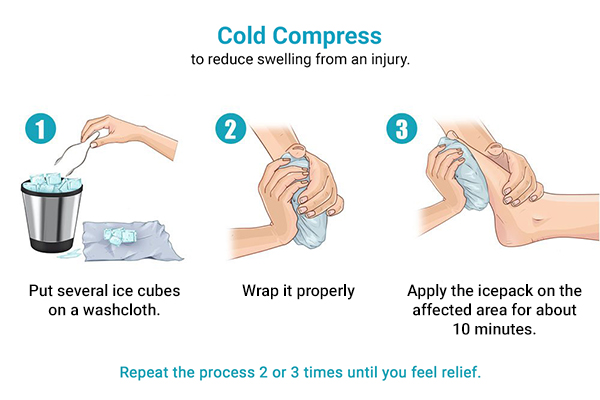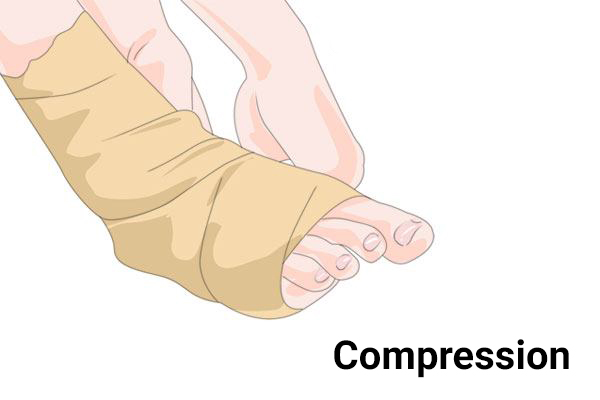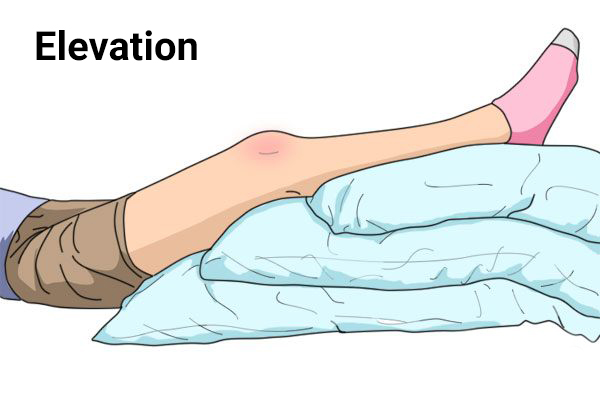In this article:
Swelling happens whenever your skin, organ, or other parts of the body enlarge as a result of fluid buildup. Swelling is one of the body’s inflammatory response to injury and has a protective value. The excess fluid protects the tissues from further injury and aids in the healing process.

Swelling resulting from injury can be quite painful and requires immediate action to prevent further damage.
The following are the common signs and symptoms of injury and inflammation at the site of the trauma:
- Pain
- Tenderness
- Fairly rapid swelling
- Bruises
- Redness
- Heat or warmth
- Loss of function
Tips to Reduce Swelling From an Injury
Here are some natural ways to relieve swelling from an injury.
1. Resting the affected area
To ensure a quick reduction of swelling caused by an injury, you need to allow the injured area to rest as much as possible for the first 24 to 72 hours. (1)
Proper rest is a key component in repairing soft tissue damage that often occurs with minor injuries. By contrast, straining the injured area will cause more swelling, pain, and delayed healing.
- If you have an injured foot or ankle, consider using crutches to take the pressure off the swollen area.
- If you have an injured arm, use the other arm to perform tasks or ask for help from others.
2. Apply a cold compress
In the first 72 hours following an acute injury, applying a cold compress is one of the best ways to minimize swelling.
Cold therapy reduces the blood flow in the injured area, consequently inhibiting the accumulation of excess fluid and, hence, swelling. It also decreases muscle spasm and metabolic demand (2) and promotes speedy functional recovery. (3)
The cold temperature offers a numbing effect on the nerves, which in turn plays a key role in pain reduction.
How to use:

- Wrap a few ice cubes in a thin towel.
- Apply this pack on the affected area for 10 minutes.
- Repeat every 3 to 4 hours.
Instead of ice cubes, you can also use a frozen bag of peas to make a cold compress.
Note: Do not apply ice directly on the skin, as it may damage the skin or even cause frostbite. Plus, ice is not a suitable treatment option for chronic injuries.
3. Compress the injured area

Compressing the injured area is another effective way to reduce swelling. (4) It provides stability and prevents fluid from accumulating in the affected area, which in turn aids in reducing the pain and swelling.
How to do:
- To apply compression, get an ACE bandage wrap or similar elastic bandage from the store.
- Wrap the bandage using even pressure around the affected area.
- Keep the bandage on during the day until the swelling reduces.
- Remove the bandage before you go to sleep.
Note: Do not wrap the bandage too tightly, or else it will hamper proper circulation.
4. Elevate the affected area

Poor circulation worsens swelling in any part of the body after injuries. Elevating the affected area, such as the hand, finger, ankle, or leg, above your chest level can help a lot to reduce swelling. (5)
Elevation improves blood circulation, resulting in relief from the discomforts associated with injury, such as swelling, pain, and other signs of inflammation. Elevation also facilitates the elimination of waste products and speeds up the healing process.
How to do:
- If your hand or fingers are swollen, you can sit on a sofa, put a few pillows on the armrest, and rest your hand on top of the pillows.
- While sleeping, place a few pillows under the affected hand or leg to keep them elevated.
- If necessary, use a sling to keep your arm or leg elevated.
5. Epsom salt soak can soothe the pain
Epsom salt is a great help when it comes to reducing swelling and pain after an injury. Made up of magnesium sulfate, Epsom salt helps improve blood circulation and relaxes stressed muscles. (6)
You can start using Epsom salt 48 hours after the injury has occurred.
How to use:

- Mix 2 tablespoons of Epsom salt in a small tub filled with warm water. Soak the affected area, such as a foot or hand, in it for 10 to 15 minutes. Repeat up to 3 times a week.
- For larger injured areas such as the legs or shoulders, you can soak your whole body in an Epsom salt bath. Mix ½ cup of Epsom salt in your bathtub filled with warm water and soak yourself in it for 15 minutes. Do this twice a week.
6. Use apple cider vinegar to reduce swelling
Apple cider vinegar is another good home remedy to reduce swelling. Its anti-inflammatory and alkalizing properties together with its potassium, calcium, and other essential mineral content help in reducing the pain and other signs of inflammation caused by injury.
How to use:
- Mix equal parts of raw, unfiltered apple cider vinegar and water. Warm up the solution in the microwave, and then soak a towel in it. Wrap the moist towel around the affected area and let it sit for 5 to 10 minutes. Repeat twice daily.
- Also, mix 1 to 2 tablespoons of raw, unfiltered apple cider vinegar in a glass of warm water. Add a little raw honey and drink this solution twice daily.
When to See a Doctor

Excessive swelling accompanied by other symptoms, such as the inability to move the swollen part of the body or intense pain, calls for immediate medical attention.
Also, if the swelling doesn’t subside in 72 hours and the pain remains at the same intensity, then consult your doctor as any delay in reducing the swelling may lead to other complications.
Final Word
Swelling is your body’s natural response to an injury. Despite the number of precautions you may take, injuries can happen at any time and any place.
You could be walking down the road and accidentally twist your foot, or you could be trying to lift a heavy bag and injure your arm in the process. The injured area will swell up soon after, making it quite painful and difficult to move. The more the swelling grows, the greater will be the discomfort.
However, you can prevent excessive swelling by immediately tending to the injured area with some simple home based interventions like the ones mentioned above. This kind of prompt care will minimize the swelling and associated discomfort to promote faster recovery.
- Was this article helpful?
- YES, THANKS!NOT REALLY



